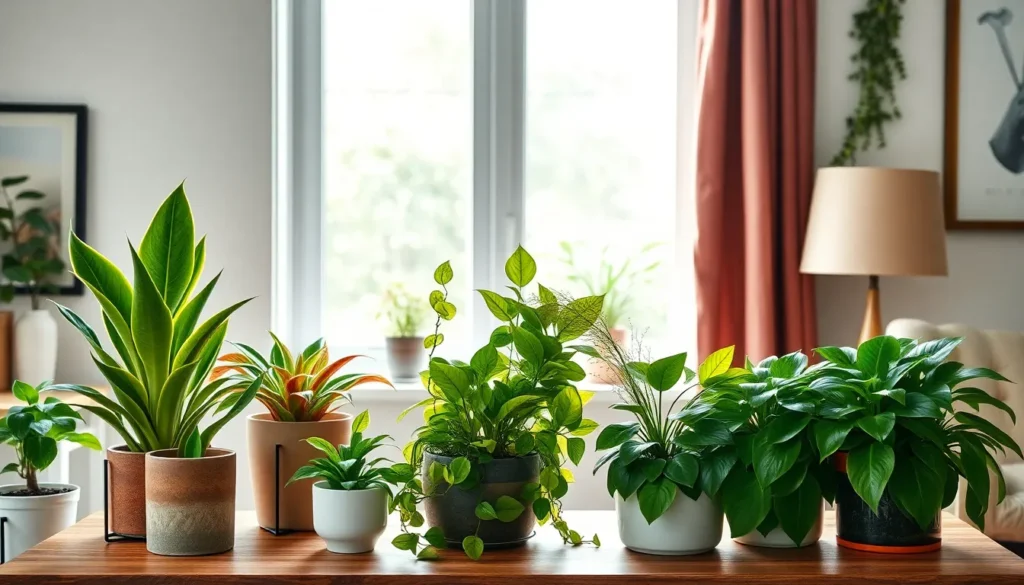We’ve all been there – staring at that dim corner of our living room wondering if we’ll ever find a plant that’ll thrive without constant sunlight. The good news? You don’t need floor-to-ceiling windows to create a lush indoor jungle that’ll make your neighbors green with envy.
Low-light indoor plants aren’t just surviving in shadowy spaces – they’re absolutely flourishing. These resilient beauties have adapted to dim conditions and they’re ready to transform your home into a botanical paradise. Whether you’re dealing with a north-facing apartment or a windowless office cubicle, there’s a perfect plant waiting to brighten your space.
We’ve spent countless hours researching and testing the most reliable low-light champions that’ll forgive your occasional neglect while delivering maximum visual impact. From dramatic foliage to air-purifying superpowers, these plants prove that low light doesn’t mean low style.
Snake Plant: The Ultimate Low-Light Champion
We’ve discovered that snake plants (Sansevieria trifasciata) stand out as the most reliable performers in dimly lit spaces.
Why Snake Plants Thrive in Dark Corners
Snake plants excel in low light conditions because they’ve evolved in the understory of West African forests where sunlight rarely penetrates. Their thick, waxy leaves store water and nutrients efficiently, allowing them to photosynthesize effectively even with minimal light exposure.
Architectural leaves create striking vertical lines that reach heights of 2-4 feet, making them perfect statement pieces for shadowy corners. The distinctive green and yellow striped pattern adds visual interest without requiring bright illumination to showcase its beauty.
CAM photosynthesis sets snake plants apart from other houseplants since they absorb carbon dioxide at night and release oxygen during darkness. This unique process means they actually prefer lower light levels during the day, thriving in spaces that receive as little as 10-20 foot candles of light.
Root systems adapt remarkably well to container life, spreading slowly through underground rhizomes that don’t require frequent repotting. We’ve observed snake plants flourishing in the same pot for 2-3 years without showing signs of stress or decline.
Care Tips for Maximum Growth
Watering schedules should follow the “less is more” principle, with thorough soaking every 2-3 weeks during growing season and monthly watering in winter. Allow soil to dry completely between waterings since snake plants store moisture in their leaves and can rot if kept consistently damp.
Soil composition works best when you use a well draining cactus or succulent mix combined with regular potting soil in a 1:1 ratio. Adding perlite or coarse sand improves drainage and prevents the waterlogged conditions that lead to root rot.
Temperature preferences remain flexible since snake plants tolerate ranges from 55-85°F, making them ideal for most indoor environments. They handle temperature fluctuations better than many houseplants, adapting to both heated and air conditioned spaces without stress.
Fertilizing routines require minimal effort with diluted liquid fertilizer applied once during spring and once in summer. Over fertilizing actually harms snake plants more than under fertilizing, so we recommend skipping feeding entirely during fall and winter months.
Cleaning maintenance involves wiping leaves monthly with a damp cloth to remove dust that can block light absorption. Use room temperature water and avoid leaf shine products that can clog the plant’s natural pores and interfere with its low light photosynthesis process.
ZZ Plant: Nearly Indestructible Beauty
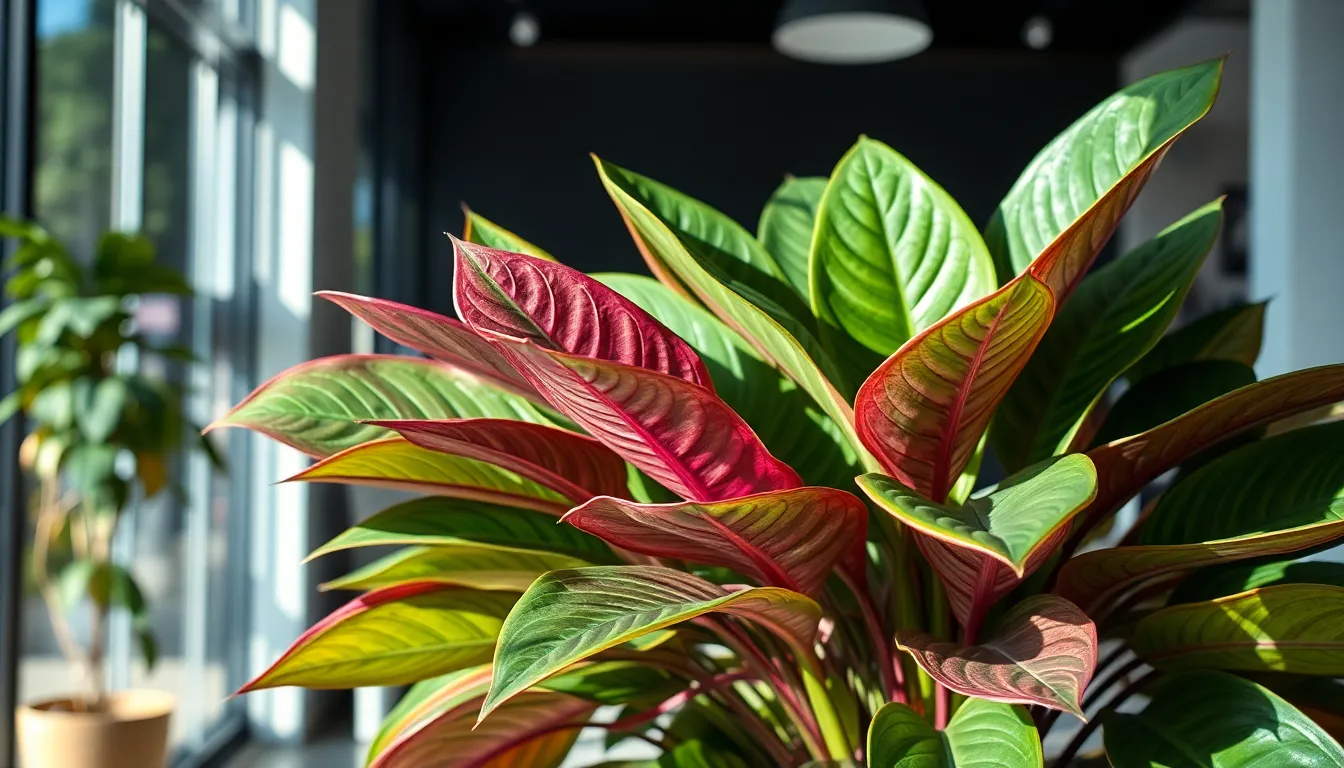
Meet the Zamioculcas zamiifolia, commonly known as the ZZ plant, which stands out as our top recommendation for those seeking an nearly maintenance-free low light companion.
Waxy Leaves That Love Shade
Thick, glossy leaves make the ZZ plant perfectly adapted for dim environments. These waxy leaves evolved to thrive in shade and tolerate low natural light exceptionally well, making them ideal for offices, homes, and commercial spaces with limited sunlight.
Architectural beauty defines every ZZ plant specimen. The distinctive waxy coating on each leaf helps the plant store moisture and nutrients efficiently, allowing it to flourish in corners where other plants would struggle.
Natural light optimization occurs through the plant’s unique leaf structure. Each waxy surface maximizes photosynthesis even in challenging lighting conditions, ensuring your ZZ plant maintains its vibrant green appearance regardless of placement.
Minimal Watering Requirements
Drought tolerance makes the ZZ plant perfect for busy plant parents. This hardy species requires minimal watering, making it highly low maintenance and ideal for those who may forget regular plant care routines.
Water storage capabilities built into the plant’s structure eliminate frequent watering needs. The thick stems and roots store moisture for extended periods, allowing the plant to survive weeks without attention.
Overwatering poses more risk than underwatering with ZZ plants. We recommend allowing the soil to dry completely between waterings, typically requiring water only once every 2-3 weeks depending on your home’s humidity levels.
Forgiving nature means the ZZ plant recovers quickly from neglect. Even if you forget to water for a month, this resilient plant bounces back with proper care, making it an excellent choice for beginners or frequent travelers.
Pothos: The Trailing Wonder for Dim Spaces
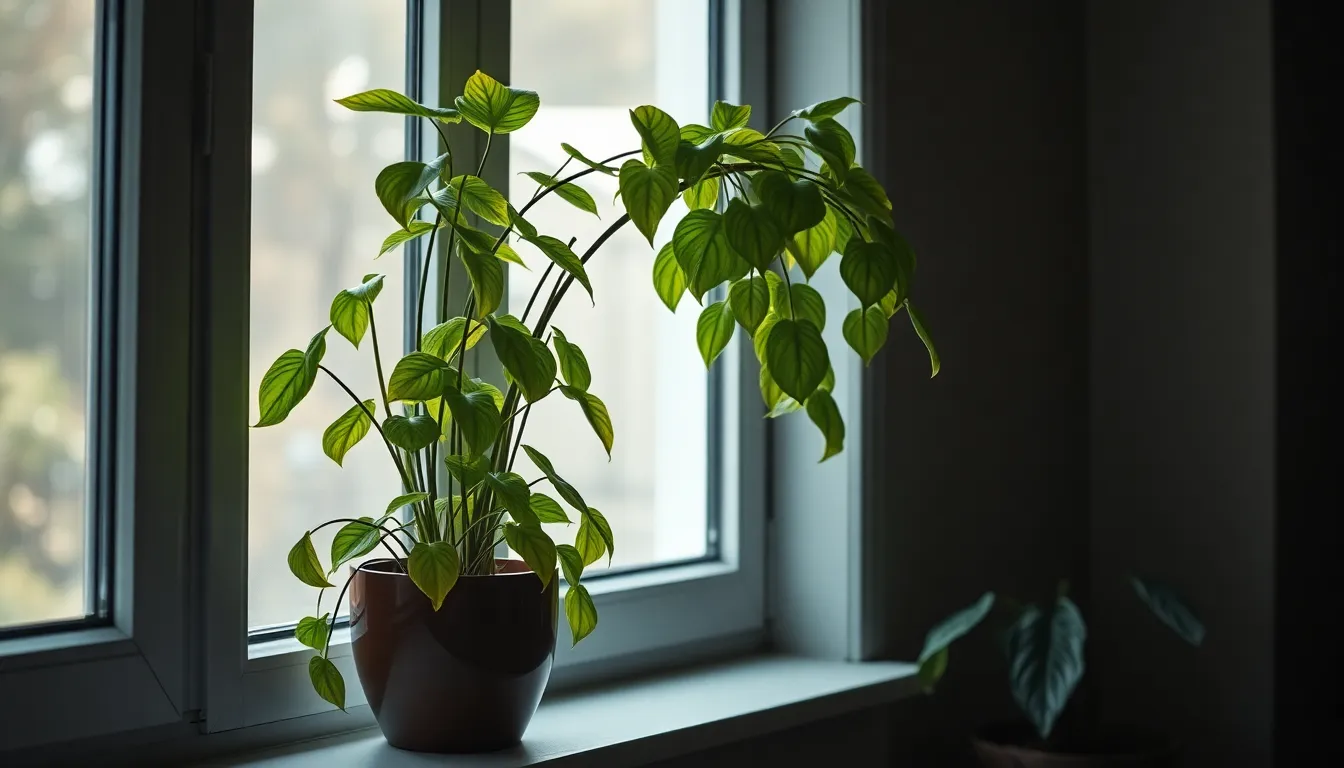
Pothos (Epipremnum aureum) stands out as one of our top recommendations for low light indoor gardening. This adaptable trailing vine brings lush greenery to the darkest corners of your home or office where other plants simply can’t survive.
Golden and Marble Queen Varieties
Golden Pothos delivers stunning visual impact with its bright green leaves adorned with striking yellow variegation. We love how this variety maintains its vibrant golden patterns even in minimal natural light conditions, making it perfect for windowless offices or dim hallways.
Marble Queen Pothos offers sophisticated elegance through its creamy white and green marbled foliage. This variety’s unique coloration adds a refined touch to any low light space while requiring zero direct sunlight to thrive. Both varieties excel in darker environments, preserving their distinctive leaf patterns and colors without fading.
Easy Propagation Methods
Stem cutting propagation works exceptionally well for expanding your Pothos collection. Simply cut a vine section just below a node where leaves attach, then place it in water or moist potting soil. Roots typically develop within 2-3 weeks using this foolproof method.
Water propagation allows you to monitor root development in real time. Place your cuttings in a clear jar filled with water and watch the roots grow before transplanting to soil once they’re well established. This technique gives you complete control over the rooting process.
Division propagation transforms larger Pothos plants into multiple new specimens. Carefully separate the root ball and pot each section individually to create instant new plants for different rooms or gifting to fellow plant enthusiasts.
Peace Lily: Elegant Blooms Without Bright Light
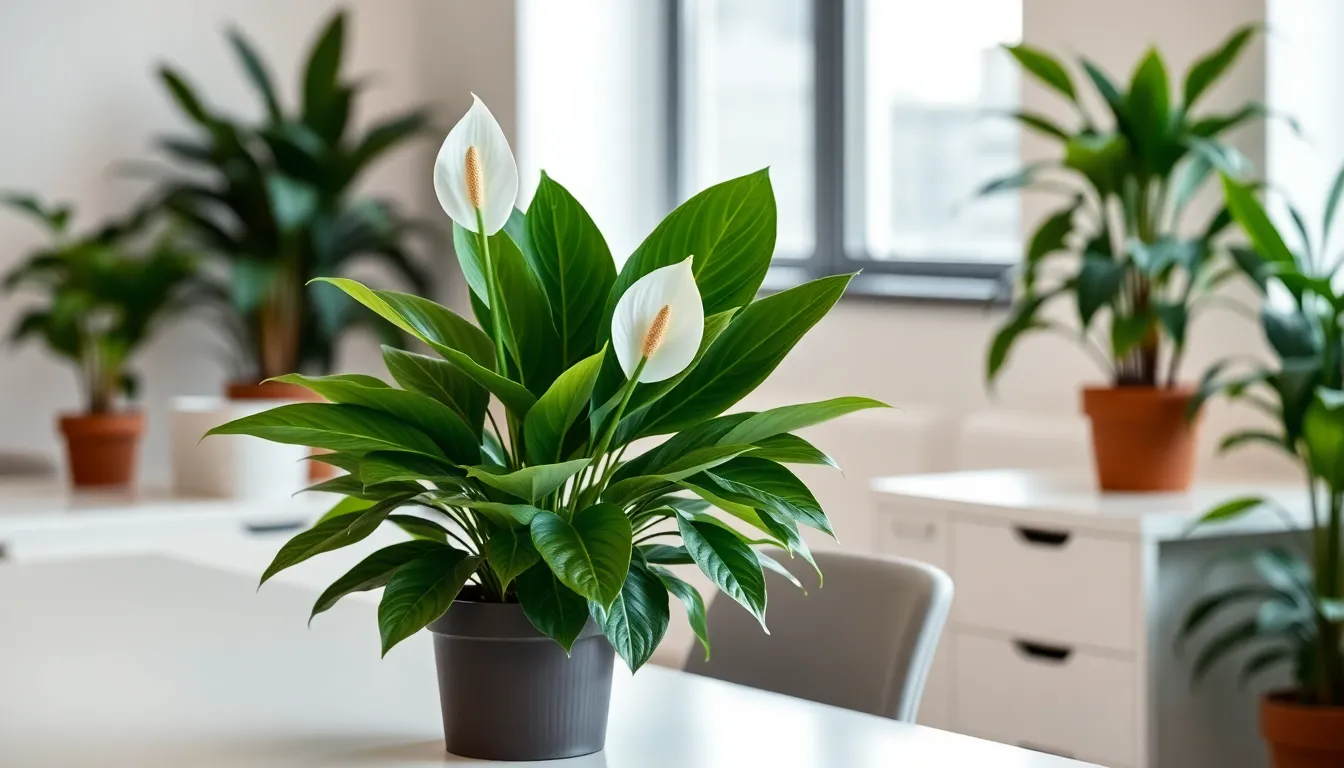
Peace Lilies bring something truly special to our low light plant collection – they’re among the few indoor plants that actually bloom beautifully in dim conditions.
Stunning White Flowers in Low Light
Peace Lilies produce striking white blooms even in low light areas, unlike many flowering plants that require bright sunlight. These elegant white flowers can brighten up dim indoor spaces, making them a popular choice for offices and homes with limited natural light. The stunning white blooms feature a distinctive spathe and spadix design that creates visual interest without needing intense lighting conditions.
Lush green foliage remains vibrant throughout the year, providing consistent beauty even when the plant isn’t flowering. We’ve found that Peace Lilies maintain their elegant appearance in spaces where other flowering plants would struggle or fail to bloom entirely. The plant’s ability to thrive in shade makes it perfect for bathrooms, bedrooms, and office cubicles where sunlight is scarce.
Air purification benefits come as an added bonus, as Peace Lilies actively improve indoor air quality while displaying their gorgeous white flowers. This dual functionality makes them exceptionally valuable for creating healthier indoor environments in low light spaces.
Signs Your Peace Lily Needs Attention
Drooping leaves indicate your Peace Lily needs water immediately, as this is the plant’s most obvious distress signal. We recommend checking the soil moisture when you notice this wilting behavior, as consistent watering schedules help prevent this issue.
Yellowing leaves may signal overwatering or poor drainage problems that need immediate correction. Brown leaf tips point to dry air conditions or inconsistent watering patterns, both of which are easily fixable with proper care adjustments.
Lack of blooms might suggest insufficient light or nutrient deficiency, though Peace Lilies can still thrive without flowering in very low light conditions. We’ve observed that moving the plant slightly closer to a window or providing occasional liquid fertilizer often encourages new bloom development.
Consistent monitoring of these warning signs helps maintain your Peace Lily’s health and ensures continued flowering in low light environments.
Chinese Evergreen: Colorful Foliage for Dark Rooms
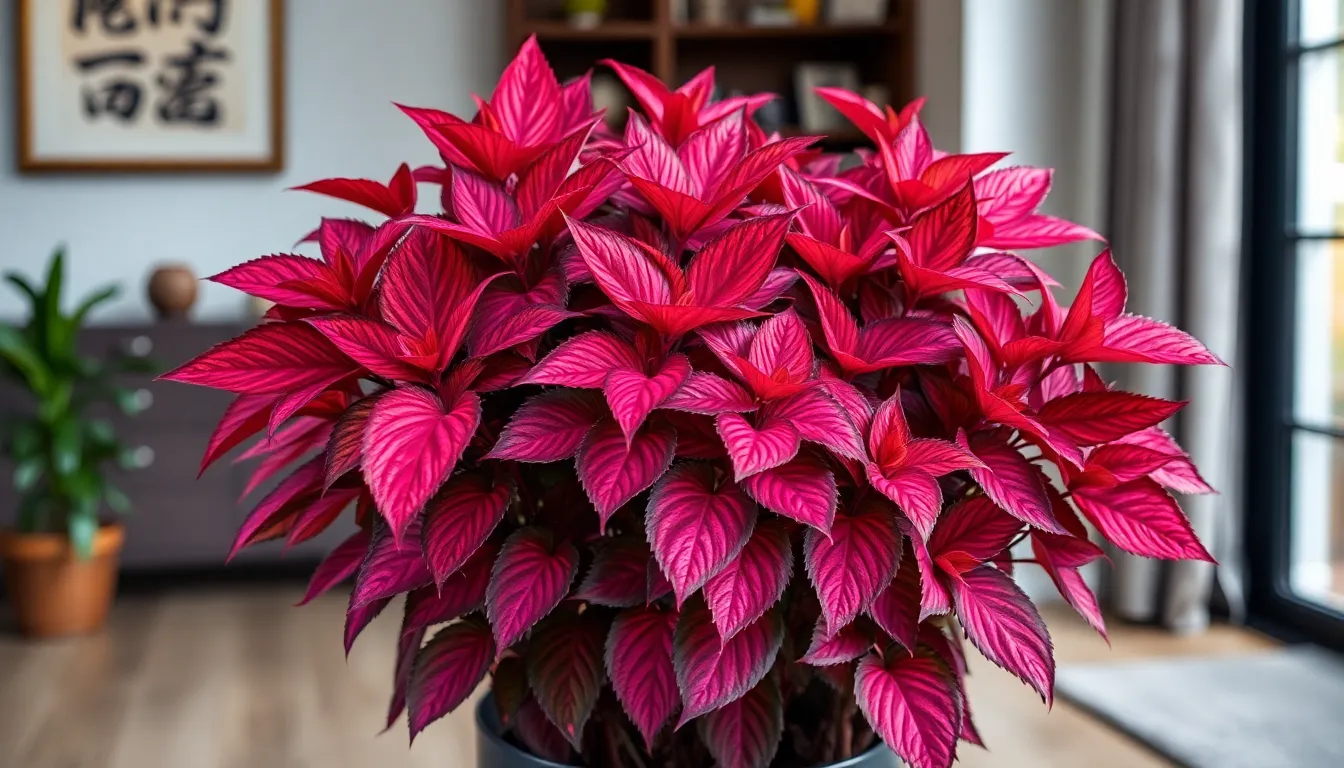
Chinese Evergreen (Aglaonema) transforms the outdated perception of plain houseplants with its stunning variety of vibrant colors and patterns. We’ve found this exceptional plant offers one of the most diverse color palettes available for low light environments.
Red, Pink, and Green Leaf Patterns
Modern Chinese Evergreen varieties showcase remarkable foliage combinations that include vibrant reds, pinks, greens, silvers, spots, and stripes all within a single plant. These lush, compact leaves feature diverse variegation patterns that create visual interest even in the darkest corners of your home.
Colorful leaf combinations make Chinese Evergreens stand out from traditional green houseplants, offering multiple hues that brighten spaces without requiring natural sunlight. We appreciate how these plants maintain their striking red, pink, and green patterns regardless of lighting conditions, making them perfect for adding both color and texture to dim areas.
Variegated foliage patterns ensure each Chinese Evergreen becomes a living piece of art that enhances any room’s aesthetic appeal. The plant’s ability to display such vivid colors while thriving in low light conditions makes it an excellent choice for interior spaces that lack adequate natural illumination.
Temperature and Humidity Preferences
Typical indoor temperatures suit Chinese Evergreens perfectly, as these adaptable plants thrive in stable environments between 65-80°F. We recommend maintaining consistent temperatures and avoiding cold drafts or extreme heat sources that can stress the plant.
Moderate to high humidity levels create optimal growing conditions, though Chinese Evergreens tolerate average household humidity without difficulty. These resilient plants adapt well to standard indoor environments while preferring slightly elevated moisture in the air.
Stable environmental conditions ensure Chinese Evergreens continue producing their colorful foliage throughout the year. We’ve observed that these plants perform best when protected from temperature fluctuations and maintained in spaces with consistent climate control.
Cast Iron Plant: Victorian Era Survivor

Meet the ultimate survivor among low light plants. We’ve discovered that the Cast Iron Plant (Aspidistra elatior) earned its nickname as the “Victorian Era Survivor” through decades of thriving in the most challenging indoor conditions.
Extremely Low Maintenance Requirements
Watering becomes nearly foolproof with Cast Iron Plants tolerating irregular schedules without complaint. You’ll find these resilient beauties forgiving extended dry periods better than most houseplants, requiring water only when their soil feels completely dry to the touch.
Neglect actually benefits these hardy specimens since overwatering poses more risk than underwatering. We recommend checking the soil monthly rather than weekly, allowing you to focus on other plants that demand more attention.
Poor lighting conditions don’t faze Cast Iron Plants at all, making them perfect for rooms without windows or areas receiving minimal artificial light. Their dark green leaves efficiently capture whatever light they receive, maintaining their lush appearance even in challenging environments.
Temperature fluctuations rarely stress these adaptable plants, unlike more sensitive varieties that require consistent conditions. They’ll thrive in typical household temperatures ranging from 50 to 85 degrees Fahrenheit without showing signs of distress.
Perfect for Forgotten Corners
Rarely visited spaces become ideal locations for Cast Iron Plants since they actually prefer being left alone rather than receiving constant attention. We’ve seen these plants flourish in basement corners, hallway nooks, and bathroom spaces where other plants would struggle.
Dim entryways transform into welcoming green spaces when you position Cast Iron Plants near doorways or staircases with limited natural light. Their upright growth habit adds vertical interest without requiring bright conditions that most plants demand.
Office environments benefit tremendously from Cast Iron Plants since they tolerate fluorescent lighting and irregular care schedules perfectly. You can place them in conference rooms, cubicle corners, or reception areas knowing they’ll maintain their appearance week after week.
Storage room adjacent areas work wonderfully for these undemanding plants, turning previously unusable spaces into subtle green retreats. Their tolerance for dust and poor air circulation makes them suitable for locations where other plants would fail to thrive.
Philodendron: Heart-Shaped Leaves for Shadowy Spots
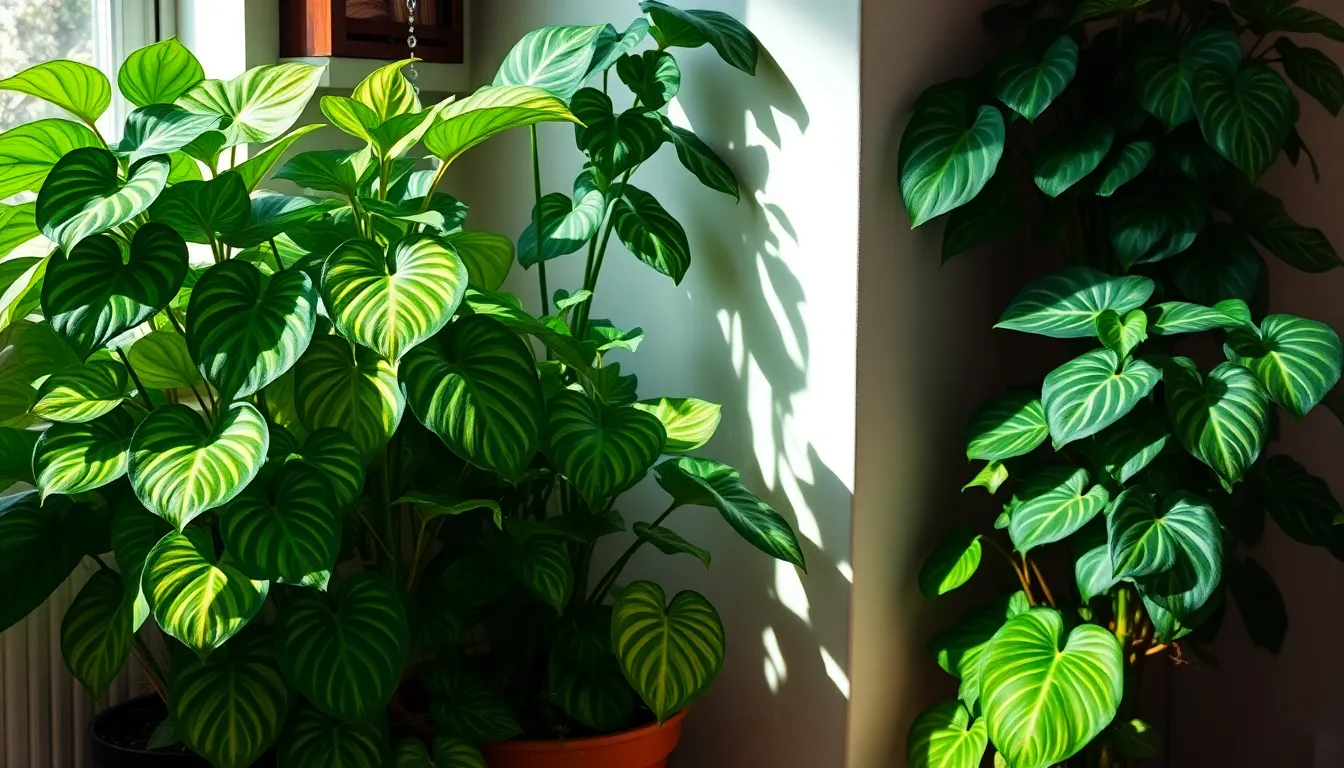
Philodendrons excel as top choices for indoor plants thriving in low light, valued for their distinctive heart-shaped leaves and remarkable adaptability to shadowy spots. These versatile vining plants bring natural beauty to the darkest corners of your home while requiring minimal care.
Heartleaf vs Brasil Varieties
Heartleaf Philodendron stands out with its solid green, glossy heart-shaped leaves that create a minimalist green aesthetic perfect for shadowy indoor spaces. Classic elegance defines this variety as it maintains consistent coloring even in dim lighting conditions. Simple care requirements make it ideal for beginners seeking reliable low-light greenery.
Brasil Philodendron offers a more vibrant alternative with striking yellow and green variegated leaves that add visual interest to dimmer areas. Colorful patterns remain vivid even though limited natural light, making this variety perfect for spaces needing a brightness boost. Enhanced visual appeal comes from the contrasting leaf coloration that creates focal points in darker rooms.
| Variety | Leaf Pattern | Best For | Light Requirements |
|---|---|---|---|
| Heartleaf | Solid green, glossy | Minimalist decor | Low to medium light |
| Brasil | Yellow-green variegated | Colorful accents | Low light with occasional bright light |
Training and Pruning Techniques
Training methods help philodendrons maintain attractive shapes while maximizing their growth potential in low-light environments. Moss poles provide excellent support structures that guide vertical growth and save valuable floor space in shadowy corners. Trellises work equally well for encouraging upward climbing habits that mimic their natural forest behavior.
Pruning techniques promote bushier growth and maintain plant health by removing leggy or yellowing stems regularly. Strategic trimming encourages new growth while preventing the plant from becoming sparse in low-light conditions. Fresh cuttings from pruning sessions can be propagated to create new plants, expanding your collection effortlessly.
Space optimization becomes simple when you train philodendrons vertically using support structures in dim areas where floor space is limited. Regular maintenance through pruning keeps these plants lush and attractive even in the most challenging indoor lighting situations. Consistent care practices ensure your philodendrons remain vibrant companions in shadowy spots throughout your home.
Dracaena: Architectural Drama in Low Light
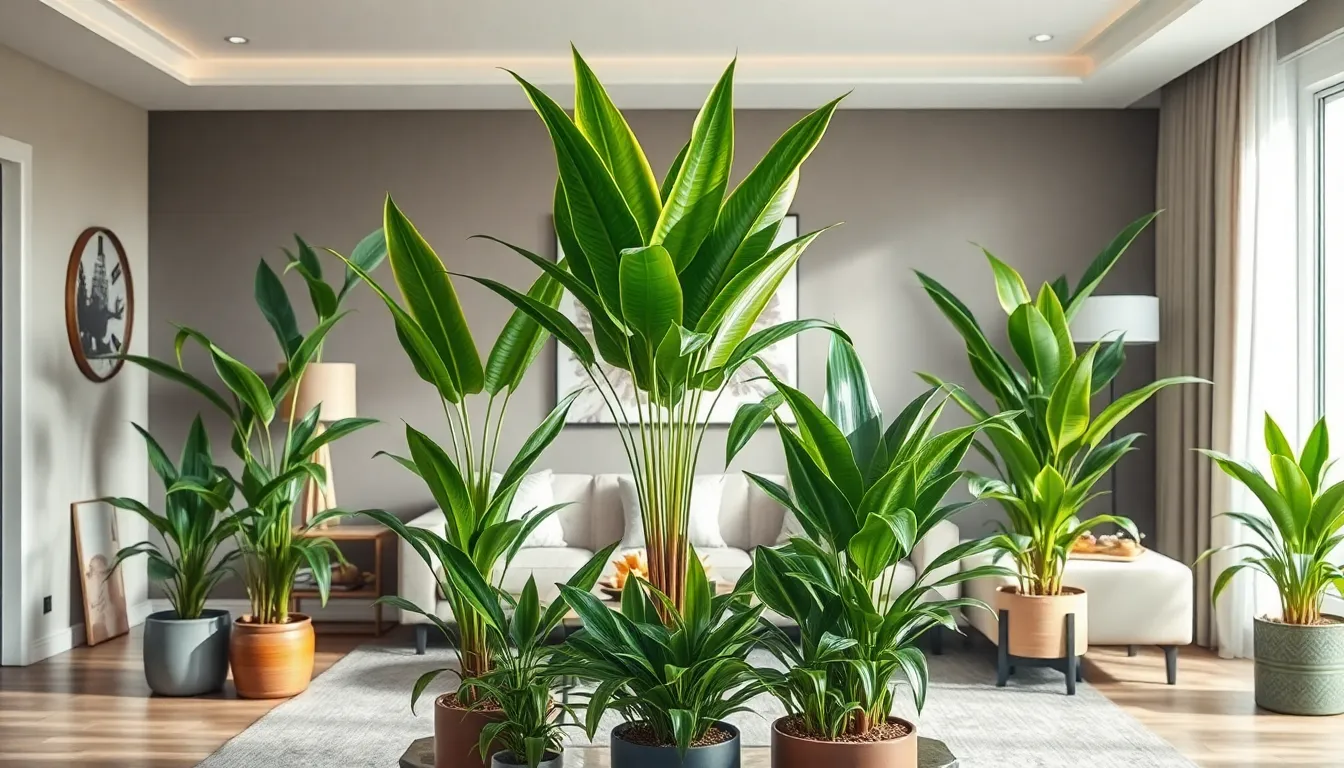
Dracaena brings sculptural elegance to dimly lit spaces while thriving where other plants struggle. We’ve discovered this versatile plant family offers exceptional tolerance for low light conditions combined with striking architectural appeal.
Different Species for Various Spaces
Dracaena fragrans (Corn Plant) features broad arching leaves with distinctive yellow central stripes that create visual interest in medium sized rooms. This variety reaches impressive heights while maintaining compact growth patterns perfect for living rooms or office spaces with limited natural light.
Dracaena marginata (Dragon Tree) showcases thin spiky leaves edged in vibrant red that deliver modern sophistication to any corner. We recommend this species for contemporary interiors where sleek vertical lines complement minimalist design aesthetics.
Dracaena deremensis displays variegated foliage with white or yellow stripes that brighten smaller indoor areas without overwhelming compact spaces. Each variety retains excellent low light tolerance while mildly brighter indirect light enhances growth rates and leaf coloration.
| Dracaena Species | Leaf Characteristics | Best Room Size | Design Style |
|---|---|---|---|
| Fragrans | Broad with yellow stripes | Medium to large | Traditional |
| Marginata | Thin with red edges | Any size | Modern |
| Deremensis | Variegated white/yellow | Small to medium | Contemporary |
Common Problems and Answers
Yellowing leaves typically indicate overwatering or drainage issues that become more pronounced in low light environments. We suggest allowing soil to dry completely between waterings since evaporation rates slow significantly in dimmer conditions.
Leaf drop often results from sudden environmental changes including temperature fluctuations or drafts near heating vents. Maintaining stable conditions away from air conditioning units prevents this stress response while supporting consistent growth patterns.
Pest issues like spider mites or scale insects occasionally appear when air circulation remains poor around dense foliage. Regular leaf wiping with damp cloths combined with insecticidal soap treatments effectively manages these problems before they spread.
Slow growth represents normal behavior in low light settings rather than a care problem requiring intervention. Avoiding heavy fertilization during winter months or dark periods prevents nutrient stress that can damage root systems.
Proper care involves sparse watering schedules, moderate humidity levels, and monthly leaf dusting that improves photosynthesis efficiency in challenging light conditions.
Monstera Deliciosa: Split-Leaf Beauty Indoors
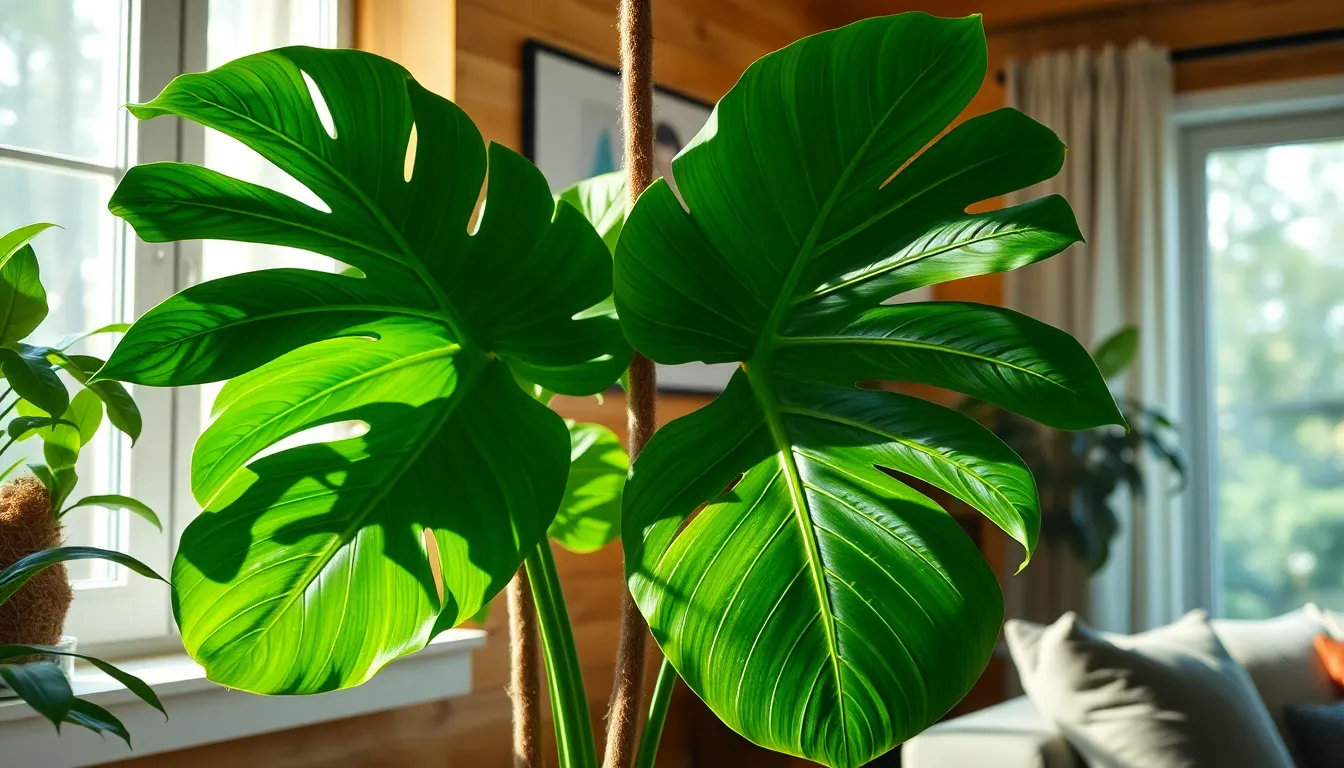
We can’t overlook the stunning Monstera Deliciosa, often called the “Swiss Cheese Plant,” which brings tropical elegance to low light spaces even though preferring brighter conditions.
Creating Fenestrations in Low Light
Fenestrations are the distinctive holes and splits that make Monstera leaves so captivating, developing as natural adaptations to maximize light capture. These signature openings appear more prominently when plants receive adequate indirect light, creating the iconic perforated appearance we love. In low light environments, your Monstera may produce fewer fenestrations and smaller leaves, as the plant conserves energy for basic survival rather than developing these ornamental features.
Understanding this natural response helps us set realistic expectations for our low light Monstera. New leaves might emerge solid or with minimal splits, gradually developing more fenestrations as they mature and the plant adjusts to available light. Patience becomes essential since fenestration development requires time and consistent care, especially in challenging lighting conditions.
Positioning your Monstera near a north facing window or using supplemental grow lights can encourage better fenestration development. Rotating the plant weekly ensures even light exposure, promoting balanced growth and more uniform leaf development throughout the canopy.
Supporting Large Growth
Supporting Monstera Deliciosa’s impressive size potential requires strategic adjustments when growing in low light conditions. These plants can produce leaves several feet wide under optimal conditions, but slower growth rates in dim environments mean we need modified care approaches. Water requirements decrease significantly since reduced photosynthesis leads to less water uptake, making overwatering a common mistake in low light settings.
Well draining soil becomes crucial for preventing root rot when growth slows down in low light environments. Using a potting mix with perlite, orchid bark, and peat moss creates the perfect balance of moisture retention and drainage your Monstera needs. Fertilizing frequency should also decrease to once every 2-3 months during growing season, as excessive nutrients can harm a slowly growing plant.
Moss poles or sturdy stakes provide necessary support as your Monstera grows, encouraging the natural climbing behavior that promotes larger leaf development. Installing support structures early prevents damage from heavy leaves and helps maintain the plant’s architectural form. Consider supplemental LED grow lights if your space receives very limited natural light, as this investment can dramatically improve both growth rate and fenestration development.
Prayer Plant: Moving Leaves That Love Shade
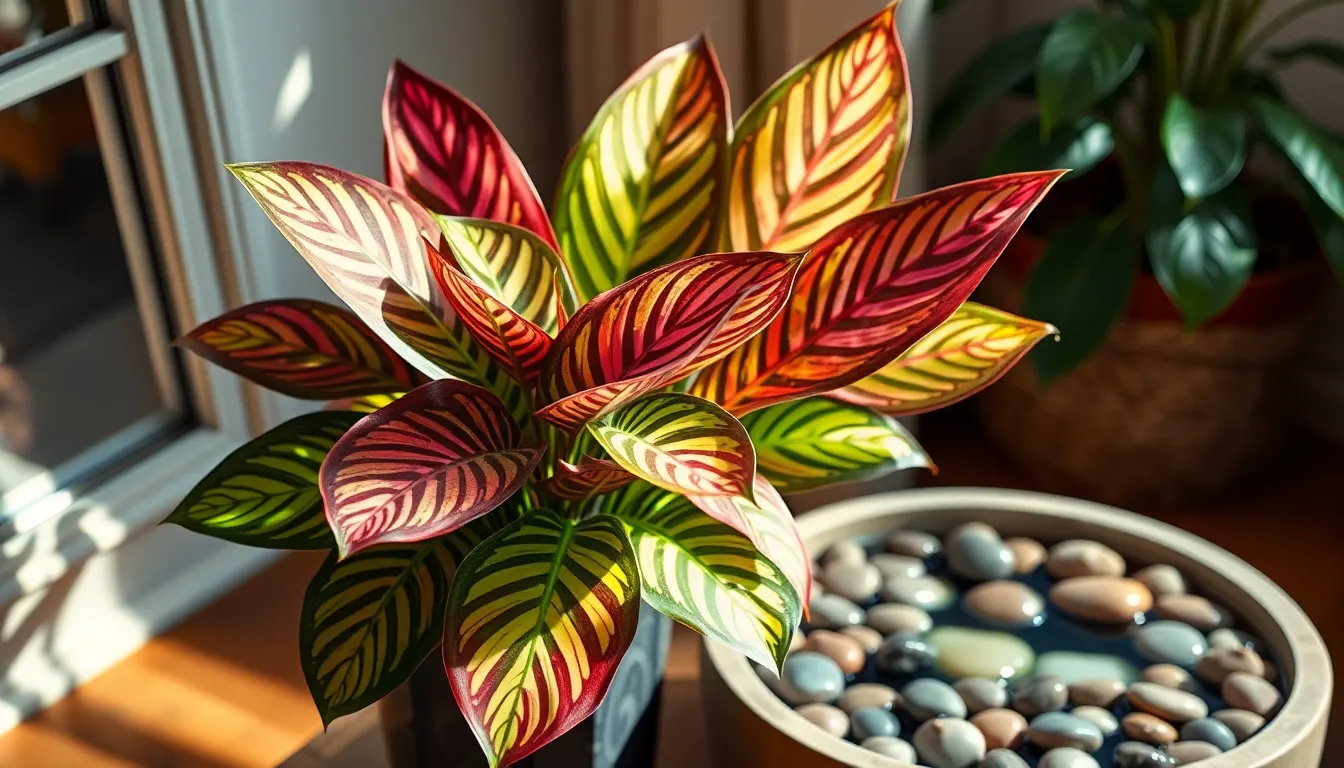
Prayer Plants bring a captivating ever-changing element to your low light indoor garden with their remarkable ability to thrive in shaded conditions. We’re consistently amazed by their unique characteristics that make them stand out among other shade loving houseplants.
Fascinating Leaf Movement Patterns
Prayer Plants showcase one of nature’s most mesmerizing behaviors through their nyctinastic movement patterns. During daylight hours, their colorful patterned leaves spread wide to capture available light, then fold upward at night like hands in prayer position. This natural rhythm responds directly to light changes and creates an almost magical display that we find endlessly fascinating.
Movement occurs gradually throughout the day as the plant adjusts to changing light conditions. Evening brings the most dramatic transformation when leaves slowly rise and fold together, creating striking silhouettes against dim lighting. Morning unfolds the reverse process as leaves gradually open and flatten to maximize light absorption.
Observing these daily movements helps us understand why Prayer Plants adapt so well to low light environments. Their leaves actively adjust positioning to capture whatever natural or artificial light is available, making them incredibly efficient in shadowy corners where other plants might struggle.
Creating Ideal Humidity Conditions
Prayer Plants require higher humidity levels to maintain their vibrant foliage and support healthy leaf movement patterns. We recommend maintaining humidity between 50-60% to keep those distinctive patterned leaves looking their best in low light conditions.
Misting provides immediate moisture relief, but we suggest focusing the spray around the plant rather than directly on leaves to prevent water spots. Grouping Prayer Plants with other humidity loving plants creates a beneficial microclimate that supports all your shade tolerant houseplants.
Humidifiers offer the most consistent moisture control, especially during winter months when indoor air becomes particularly dry. Placing a small humidifier near your Prayer Plant collection ensures steady humidity levels without the daily maintenance that misting requires.
Pebble trays filled with water create localized humidity zones around individual plants. We place shallow dishes filled with decorative stones and water beneath Prayer Plant containers, allowing natural evaporation to increase moisture levels gradually throughout the day.
Conclusion
We’ve explored an incredible variety of resilient plants that prove low light doesn’t mean sacrificing beauty or greenery in your space. From the architectural drama of snake plants to the tropical elegance of Monstera and the mesmerizing movements of prayer plants each option offers unique benefits that go far beyond basic survival.
The key to success lies in understanding that these plants have evolved exact adaptations that make them thrive rather than simply tolerate dim conditions. Whether you’re drawn to the vibrant colors of Chinese evergreens or the classic reliability of cast iron plants you now have the knowledge to make informed choices.
Transform those forgotten corners and shadowy spaces into thriving green sanctuaries. With proper care techniques and realistic expectations these low-light champions will reward you with years of lush growth and natural beauty that brightens even the darkest rooms.
Frequently Asked Questions
What are the best indoor plants for low-light conditions?
The top low-light indoor plants include Snake Plant (Sansevieria), ZZ Plant (Zamioculcas zamiifolia), Pothos, Peace Lily, Chinese Evergreen, Cast Iron Plant, Philodendron, Dracaena, Monstera Deliciosa, and Prayer Plant. These plants have adapted to thrive in dim environments and require minimal maintenance while providing aesthetic appeal and air purification benefits.
How often should I water low-light indoor plants?
Most low-light plants prefer infrequent watering. Snake plants and ZZ plants need water only when soil is completely dry, typically every 2-3 weeks. Peace Lilies will droop when thirsty, making it easy to know when to water. Generally, low-light plants require less water than those in bright conditions due to slower growth rates.
Can low-light plants survive in offices with only fluorescent lighting?
Yes, many low-light plants thrive under fluorescent lighting. Cast Iron Plants are particularly well-suited for office environments, tolerating artificial lighting and dust. Snake Plants, ZZ Plants, and Pothos also adapt well to office conditions, making them excellent choices for brightening up workplace environments with minimal natural light.
Do low-light plants still purify the air effectively?
Absolutely! Low-light plants like Snake Plants, Peace Lilies, and Pothos are excellent air purifiers. Snake Plants uniquely release oxygen at night through CAM photosynthesis, while Peace Lilies effectively remove common indoor air pollutants. These plants maintain their air-cleaning properties even in dim lighting conditions.
Will variegated plants lose their colors in low light?
Some variegated plants maintain their patterns in low light better than others. Golden Pothos and Marble Queen Pothos preserve their distinctive variegation even in minimal light. Chinese Evergreens retain their vibrant colors year-round. However, some plants may develop less pronounced variegation in very dim conditions but won’t lose it completely.
How do I know if my low-light plant is getting too little light?
Signs of insufficient light include excessive stretching toward light sources, smaller new leaves, loss of variegation in patterned plants, and slow or stunted growth. While low-light plants tolerate dim conditions, they still need some light to photosynthesize. Consider relocating the plant closer to a window or adding supplemental grow lights.
Can I propagate low-light plants easily?
Yes, many low-light plants are easy to propagate. Pothos can be propagated through stem cuttings in water or soil, and by division. Philodendrons also root easily from cuttings. Snake Plants can be propagated by leaf cuttings or division. This makes it simple to expand your plant collection or share with friends.
Do low-light plants need fertilizer?
Low-light plants require minimal fertilization since they grow slowly. Most benefit from light feeding during growing season (spring and summer) with diluted liquid fertilizer every 2-3 months. Snake Plants and ZZ Plants need very little fertilizer, while Peace Lilies may benefit from occasional feeding to encourage blooming.
What’s the biggest mistake people make with low-light plants?
Overwatering is the most common mistake with low-light plants. Since these plants grow slowly and use less water in dim conditions, they’re more susceptible to root rot from excessive moisture. Always check soil moisture before watering and ensure pots have drainage holes to prevent waterlogged conditions.
How can I increase humidity for plants that need it?
For humidity-loving plants like Prayer Plants and Peace Lilies, try grouping plants together, using pebble trays filled with water, misting regularly, or using a humidifier. Placing plants in naturally humid areas like bathrooms (if they have some light) can also help maintain the moisture levels these plants prefer.

